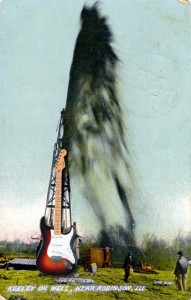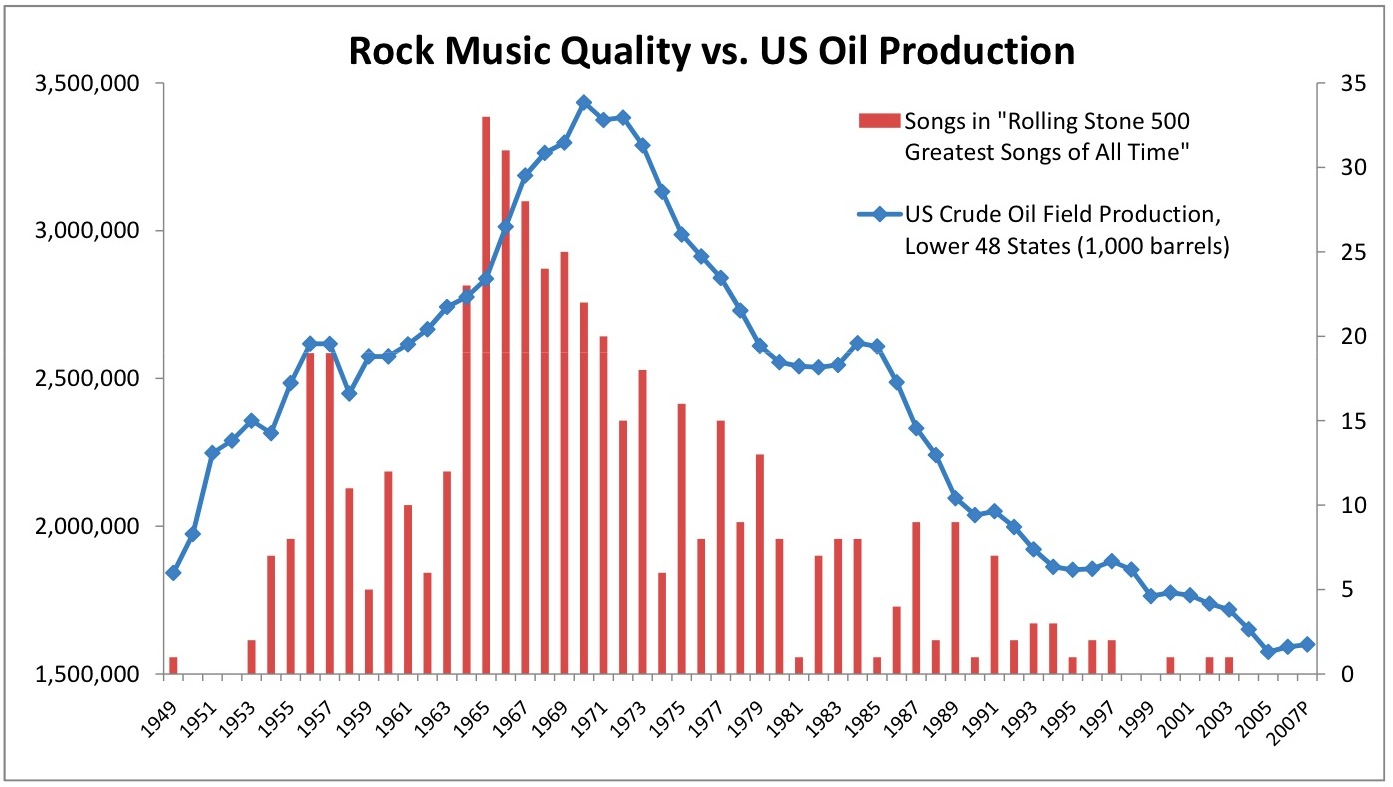Many rock purists and music snobs (myself included) often lament the quality of most modern pop/rock music. “Music these days is so trite and derivative,” they say. “It’s just been downhill since the 60’s and 70’s. Those were the days.”
A few years ago, Rolling Stone magazine added fuel to the music snobbery fire with its “500 Greatest Songs of All Time” list. Anyone casually paging through the list would notice that the bulk of the list was comprised of songs from the 60’s and 70’s, just like the music snobs always say.
I, however, wasn’t content with the casual analysis. So I punched the list into Excel, crunched some numbers, and found an interesting parallel between the decline of rock music quality and, of all things, the decline in US oil discovery and production:
(Sources: Rolling Stone Magazine, US Department of Energy)
Analysis after the jump. Drill Baby Drill!

Including, it would seem, rock & roll. I know, the RS 500 list is not without its faults, but it does allow for some attempt at quantifying a highly subjective and controversial topic and for plotting the number of “greatest songs” over time. Notice that after the birth of rock & roll in the 1950’s, the production of “great songs” peaked in the 60’s, remained strong in the 70’s, but drastically fell in the subsequent decades. It would seem that, like oil, the supply of great musical ideas is finite. By the end of the 70’s, The Beatles, Led Zeppelin, Black Sabbath, the Motown greats, and other genre innovators quickly extracted the best their respective genres** had to offer, leaving little supply for future musicians.
The counterargument to all of this, of course, is that the RS 500 skews unfairly towards the earliest, most groundbreaking works of music and unfairly penalizes later creations for simply coming after other works. For example, why was Green Day shut out of the list? I could point to dozens of songs on the RS 500 that are inferior to some of the classic tracks off of Dookie, almost all of which came from the 60’s and 70’s. But even if you assume that the RS 500 functions more of an indicator of musical early-ness, the Hubbert Peak Theory still holds true. A whole host of talented musicians set out exploring the vast uncharted territory of modern pop/rock music that was first made possible by the electric guitar and the standardization of the rhythm section. The resulting works from this period (the 50’s, 60’s, and 70’s) will forever stand out by virtue of their originality. Popular music** may never again see a period of innovation at a magnitude of its first explosion.
I don’t think I’m being pessimistic about the outlook on pop/rock music or snobbish about my retro music tastes. I think the same idea applies to other creative fields that follow a similar arc of rapid exploration followed by derivative works. Assuming some constraints on the definition of the form, the amount of innovation that can be done within that form is finite. Most of it will come early and fast, then decline after the peak. Impressionist paintings. Star Wars movies. I could go on.
Now, if only we could drill for some new reserves of pop music innovation. Perhaps there’s a new Motown hit machine waiting somewhere in the Gulf of Mexico, waiting to be unleashed. Let’s get drilling.
I know there’s plenty of room for arguing my points, so please sound off in the comments.
*I left off Alaska from the data set mostly to make the graphs line up better, but also because the “fixed supply” concepts holds better if you look solely at the lower 48 states and not the one with all the oil and all the hockey moms.
**Although the RS 500 list includes a smattering of rap/hip-hop, it’s so deficient in that regard that i’m excluding that genre from this analysis. I wonder, though, if a similar analysis could be conducted around that genre that shows the discovery/innovation explosion after hip hop’s genesis in the late 1970’s.

